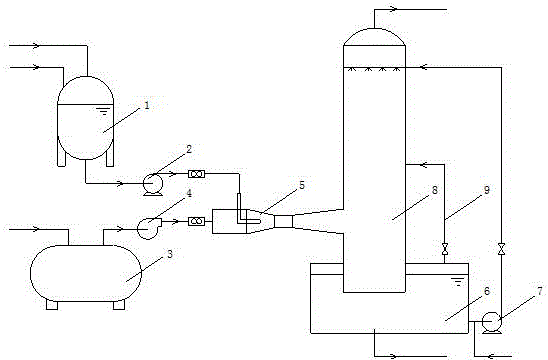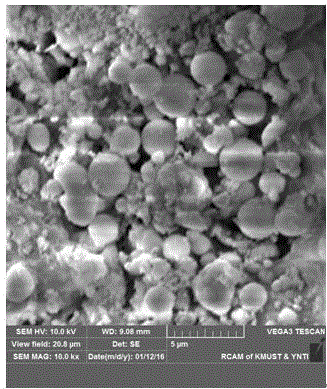Method for simultaneously treating chlorsilane residual liquor and waste gas
A technology of simultaneous treatment of chlorosilane residual liquid, applied in chemical instruments and methods, silicon oxide, silicon dioxide, etc., can solve problems such as high local silicic acid concentration, environmental pollution, poor dispersion or atomization effect, etc., to achieve Reduce construction costs and operating costs, improve hydrolysis absorption efficiency, and facilitate safe operation
- Summary
- Abstract
- Description
- Claims
- Application Information
AI Technical Summary
Problems solved by technology
Method used
Image
Examples
Embodiment 1
[0036] A method for simultaneously treating chlorosilane raffinate and waste gas described in this embodiment is characterized in that it comprises the following steps:
[0037](1) The chlorosilane raffinate produced by the polysilicon production unit enters the raffinate storage tank 1, and uses nitrogen as a protective gas to fill the remaining space of the raffinate storage tank, and the chlorosilane waste gas produced by the polysilicon production unit enters the waste gas buffer tank 3;
[0038] (2) Use the residual liquid delivery pump 2 to pump the chlorosilane residual liquid (the flow rate is 25L / h) to the liquid inlet pipe of the Venturi atomizer 5, and use the fan 4 to pump the chlorosilane waste gas (the flow rate is 50m 3 / h) into Venturi atomizer 5, chlorosilane residual liquid and chlorosilane waste gas are mixed and atomized in the shrinkage section and venturi atomizer throat, and the liquid-gas ratio of the atomizer is 0.5L / m 3 ;
[0039] (3) The mixed and a...
Embodiment 2
[0042] A method for simultaneously treating chlorosilane raffinate and waste gas described in this embodiment is characterized in that it comprises the following steps:
[0043] (1) The chlorosilane raffinate produced by the polysilicon production unit enters the raffinate storage tank 1, and uses nitrogen as a protective gas to fill the remaining space of the raffinate storage tank, and the chlorosilane waste gas produced by the polysilicon production unit enters the waste gas buffer tank 3;
[0044] (2) Pump chlorosilane raffinate (flow rate: 40L / h) to Venturi atomizer 5 with raffinate delivery pump 2, and blow chlorosilane waste gas (flow rate: 55m 3 / h) into Venturi atomizer 5, chlorosilane residual liquid and chlorosilane waste gas are mixed and atomized at the shrinkage section and venturi atomizer throat, and the liquid-gas ratio of the atomizer is 0.73L / m 3 ;
[0045] (3) The mixed and atomized gas is washed down from the upper part of the tower by the absorbent in th...
Embodiment 3
[0047] A method for simultaneously treating chlorosilane raffinate and waste gas described in this embodiment is characterized in that it comprises the following steps:
[0048] (1) The chlorosilane raffinate produced by the polysilicon production unit enters the raffinate storage tank 1, and uses nitrogen as a protective gas to fill the remaining space of the raffinate storage tank, and the chlorosilane waste gas produced by the polysilicon production unit enters the waste gas buffer tank 3;
[0049] (2) Pump chlorosilane raffinate (flow rate: 30L / h) to Venturi atomizer 5 liquid inlet pipe with raffinate pump 2, and blow chlorosilane waste gas (flow rate: 30m 3 / h) into Venturi atomizer 5, chlorosilane residual liquid and chlorosilane waste gas are mixed and atomized at the shrinkage section and venturi atomizer throat, and the liquid-gas ratio of the atomizer is 1L / m 3 ;
[0050] (3) The mixed and atomized gas is washed down from the upper part of the tower by the absorbent...
PUM
 Login to View More
Login to View More Abstract
Description
Claims
Application Information
 Login to View More
Login to View More - R&D
- Intellectual Property
- Life Sciences
- Materials
- Tech Scout
- Unparalleled Data Quality
- Higher Quality Content
- 60% Fewer Hallucinations
Browse by: Latest US Patents, China's latest patents, Technical Efficacy Thesaurus, Application Domain, Technology Topic, Popular Technical Reports.
© 2025 PatSnap. All rights reserved.Legal|Privacy policy|Modern Slavery Act Transparency Statement|Sitemap|About US| Contact US: help@patsnap.com



